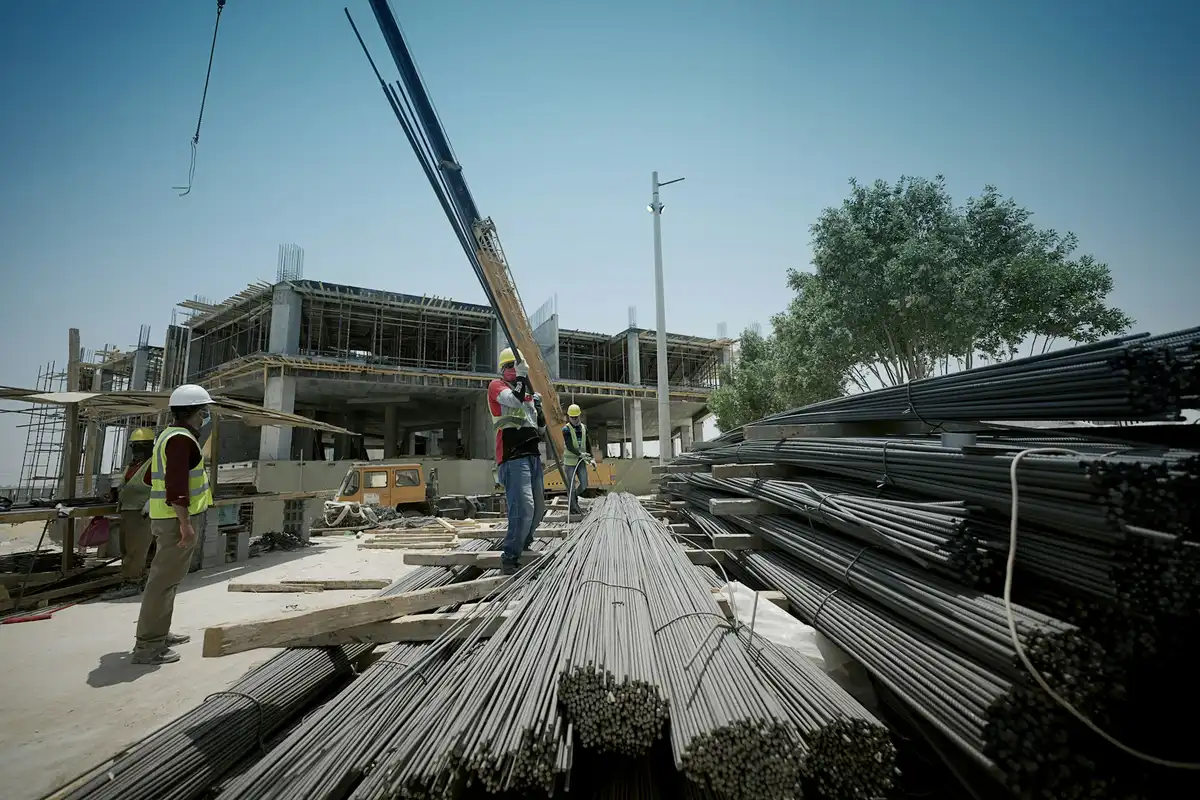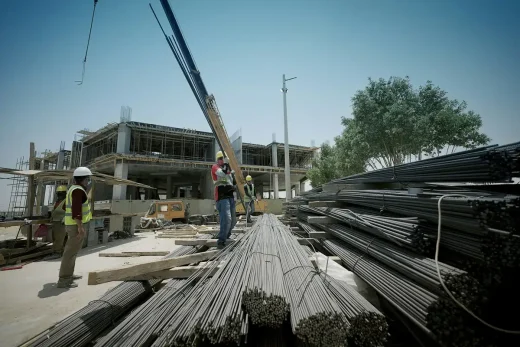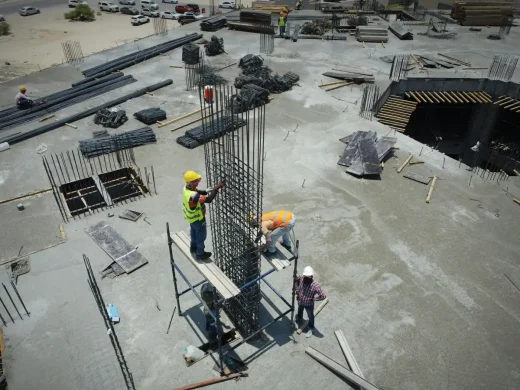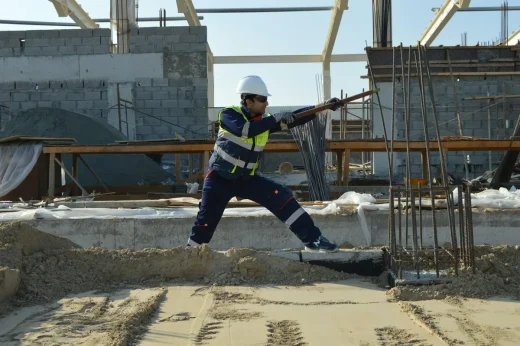Prevent construction site accidents tips, Building safely, H&S build hazards
7 Tips to Prevent Accidents on Construction Sites
1 November 2024
The construction industry ranks among the highest for workplace injuries and fatalities. According to the Occupational Safety and Health Administration (OSHA), over 21% of all workplace deaths in the United States occur on construction sites. Preventing these accidents requires targeted measures supported by precise data and consistent implementation. This article presents effective strategies for minimizing the risks that contribute to construction site accidents.
1. Conduct Thorough Risk Assessments
Importance of Detailed Risk Assessments
Risk assessment is the first step in reducing construction accidents. A documented, thorough risk assessment is mandatory for companies with more than five employees in numerous jurisdictions. This legal requirement ensures that organizations understand and plan for potential hazards on a specific worksite.
Key Facts and Procedures
Risk assessments identify and evaluate the hazards present in a particular environment. To ensure accuracy, these assessments need to include:
- Type of Work: Analyze tasks, such as roofing or demolition, that carry specific risks.
- Work Environment: Consider factors such as elevation, uneven ground, and weather.
- Hazard Identification: List hazards such as fall risks, electrocution, and equipment malfunction.
For example, if workers need to work at height on a scaffold, the risk assessment must include potential fall hazards, the condition of the scaffold, and environmental factors like wind speed. This documentation allows site managers to allocate resources, such as safety harnesses and guardrails, effectively and ensures compliance with local regulations.
2. Provide Comprehensive Safety Training
The Role of Training in Accident Prevention
Safety training ensures that workers know how to operate equipment, respond to emergencies, and recognize hazards. The Occupational Safety and Health Administration emphasizes that safety training should cover emergency procedures, correct use of personal protective equipment (PPE), and understanding site-specific risks.
Key Elements of a Comprehensive Safety Training Program
- Written Safety Policy: Develop a written safety policy outlining all safety procedures, including hazard identification, emergency protocols, and PPE guidelines.
- Regular Training Sessions: Schedule ongoing training, especially for employees working with new equipment or processes. For instance, if workers are exposed to electrical hazards, training should emphasize the proper handling of electrical tools and awareness of overhead power lines.
- Use of Safety Software: Many construction companies use tools like SafetySuite for effective safety and injury management. SafetySuite, trusted by SAP customers for over 25 years, offers a configurable solution for proactive safety management. This tool enables real-time tracking and reporting of safety incidents and compliance with safety standards, making it an invaluable resource for minimizing risks.
By implementing training programs supported by robust software like SafetySuite, companies can reduce accident rates and protect workers.
3. Maintain Tools and Equipment
Why Tool and Equipment Maintenance is Essential
Well-maintained equipment minimizes malfunctions that lead to injuries. Malfunctions account for a significant percentage of accidents, often due to neglected maintenance. Following manufacturers’ specifications for inspection and maintenance is critical for equipment safety on construction sites.
Maintenance Procedures and Protocols
- Routine Inspections: Schedule inspections for all equipment based on manufacturer recommendations. For example, a power saw should be checked for blade condition, electrical connections, and handle integrity before each use.
- Immediate Repairs or Replacement: If an inspection reveals damage—such as frayed electrical cords, dull blades, or unstable parts—repair or replace the equipment before use. Faulty tools significantly increase the risk of accidents.
- Documentation of Maintenance: Maintain records of each inspection and repair. These records are essential in case of an audit and help track equipment conditions over time.
Well-maintained tools and equipment not only reduce the likelihood of accidents but also increase productivity, as properly functioning tools contribute to more efficient work.
4. Keep Work Areas Clean and Organized
Impact of Clean Workspaces on Safety
A clean and organized workspace plays a critical role in preventing slips, trips, and falls, which rank among the most frequent causes of injuries on construction sites. According to OSHA, slips, trips, and falls accounted for over 25% of reported workplace injuries in 2020. Ensuring a debris-free environment minimizes the risk of such incidents.
Key Practices for Maintaining Clean and Safe Work Areas
- Clear Walkways Regularly: Remove all debris, tools, and materials from walkways and paths to ensure unimpeded movement. For example, clear any unused cables or construction materials blocking aisles to prevent tripping.
- Promptly Address Spills: Clean any spills immediately. IF liquid is left unattended, THEN workers are at risk of slipping, particularly in high-traffic zones like entrances and exits.
- Organize Tools and Equipment: Store tools in designated areas when not in use. For instance, set up storage racks or cabinets for equipment, reducing clutter and allowing easy access without compromising movement.
- Assign Cleaning Responsibilities: Each worker should take responsibility for maintaining their workspace cleanliness. At the end of each shift, conduct a brief inspection to ensure all areas are clear and ready for the next day’s work.
By following these structured procedures, work areas remain organized, reducing preventable accidents and promoting a safer construction environment.
5. Implement Fall Protection Measures
Significance of Fall Protection on Construction Sites
Falls are the leading cause of construction-related fatalities, accounting for approximately 30% of industry deaths, according to OSHA data. These incidents often occur on scaffolds, ladders, and rooftops, making fall protection equipment essential.
Primary Fall Protection Measures
- Provide Fall Protection Equipment: Equip all workers exposed to heights with fall protection gear, such as harnesses, guardrails, and safety nets. For example, a worker on scaffolding higher than six feet should wear a full-body harness connected to an anchor point.
- Install Guardrails and Safety Nets: Use guardrails on elevated platforms and safety nets in areas with open edges. In cases where platforms lack built-in barriers, temporary guardrails must be installed to prevent accidental falls.
- Ensure Proper Training for Fall Prevention: All employees working at heights need training in the proper use of fall protection gear. Training sessions should cover fitting harnesses correctly and connecting to anchor points. Regular refresher training helps workers stay current on safety practices.
- Conduct Regular Inspections: Inspect fall protection equipment daily before each use. IF a harness shows signs of wear, THEN replace it immediately. Damaged gear significantly reduces effectiveness and increases fall risk.
Implementing these measures creates a safer environment for workers, reducing fatal falls and meeting OSHA’s construction safety standards.
6. Encourage Effective Communication
The Role of Communication in Accident Prevention
Clear and consistent communication is essential in identifying and mitigating hazards on construction sites. By fostering an environment where workers feel empowered to discuss safety issues openly, companies can preemptively address potential risks.
Strategies for Improving Communication on Construction Sites
- Hold Regular Safety Meetings: Schedule daily or weekly safety meetings to discuss current site conditions, potential hazards, and updates on safety protocols. For example, during a morning briefing, supervisors can remind workers about fall risks on higher levels and reinforce the use of harnesses.
- Encourage Hazard Reporting: Workers should feel comfortable reporting hazards without fear of retribution. IF an employee observes a loose scaffold plank, THEN they should immediately inform a supervisor, allowing for quick corrective action.
- Provide Clear Safety Signage: Post visible safety signs in high-risk areas, such as “Wear PPE Beyond This Point” or “Caution: Wet Floor.” This signage alerts workers and visitors to hazards before they enter potentially unsafe zones.
- Utilize Mobile Communication Tools: Many construction sites now use mobile apps or platforms to enable quick reporting of incidents and hazards. For instance, a worker could report an equipment malfunction through a digital form, notifying the maintenance team immediately.
By promoting effective communication, construction sites become safer as workers actively participate in hazard identification and prevention. This collaborative approach fosters a culture of accountability and safety among the workforce.
Even with open communication and strong safety protocols, accidents can still occur. Sometimes it’s due to ignored warnings or unresolved hazards. In these cases, a personal injury lawyer can help injured workers hold responsible parties accountable, ensure that workers’ rights are protected, and that they receive the compensation they deserve.
7. Use Personal Protective Equipment (PPE)
Importance of PPE on Construction Sites
Personal Protective Equipment (PPE) is essential for minimizing exposure to specific hazards on construction sites. According to OSHA, inadequate PPE use leads to approximately 10% of non-fatal injuries each year. Properly equipping workers with suitable PPE, along with consistent training in its use, prevents a significant number of avoidable injuries.
Types of Essential PPE and Their Uses
- Hard Hats: Protects the head from impacts caused by falling objects or accidental bumps with structures. For example, hard hats are essential when working in areas with overhead risks, such as under scaffolding.
- Safety Glasses and Face Shields: Prevent eye injuries from dust, debris, and chemical splashes. IF workers use power tools like grinders or drills, THEN they must wear safety glasses or face shields to protect against flying particles.
- Gloves: Necessary for handling rough or hazardous materials, gloves reduce risks of cuts, abrasions, and chemical exposure. Different tasks require specific types of gloves; for example, welding gloves offer heat resistance, while cut-resistant gloves protect against sharp objects.
- Hearing Protection: Includes earplugs and earmuffs, which safeguard workers in high-noise areas. According to OSHA, prolonged exposure to noise levels over 85 dB can cause permanent hearing loss, making hearing protection crucial in areas with loud machinery, such as jackhammers and drills.
- High-Visibility Clothing: Ensures workers are visible, particularly in low-light conditions or near heavy machinery. Workers operating in proximity to vehicles or machinery should wear high-visibility vests to prevent accidental strikes.
- Respirators: Protect against inhaling harmful dust, fumes, and other airborne particles. For instance, when handling cement or cutting wood, respirators reduce inhalation risks, ensuring workers avoid respiratory issues.
By enforcing proper PPE use, construction companies can substantially reduce the risk of injury from site hazards, promoting a safer working environment.
Understanding the Common Causes of Construction Accidents (Supporting Facts)
Understanding the common causes of construction accidents allows companies to develop targeted prevention strategies. Each major cause presents specific hazards that can be mitigated through targeted interventions.
1. Falls
Falls are the leading cause of fatalities in construction, accounting for approximately 39.2% of industry deaths in 2017. Falls occur mainly due to unsecured heights, slippery surfaces, and inadequate fall protection.
Common Scenarios:
- Unsecured Heights: Falls from scaffolding, roofs, and ladders are frequent without proper harnesses and guardrails.
- Slippery Surfaces: Workers often slip on wet or uneven ground, particularly after rainfall or when surfaces are improperly maintained.
- Openings and Unguarded Edges: Falls through unguarded skylights or edges are preventable with adequate guardrails and warning signs.
Employers should consistently implement fall protection measures, including safety nets, to decrease these risks.
2. Struck-by Object Incidents
Struck-by injuries result from moving objects impacting workers, making up 8.2% of construction fatalities. Common sources of these incidents include dropped tools, loose materials, and on-site vehicles.
- Examples of Struck-by Incidents:
- Objects Falling from Heights: Tools or materials falling from scaffolds or platforms can severely injure workers below.
- Moving Vehicles and Machinery: Workers near operating equipment are at risk of being struck or pinned. High-visibility clothing and designated pathways for foot traffic mitigate these risks.
Struck-by incidents can be prevented by ensuring tools are secure, using barriers, and implementing rigorous vehicle safety protocols.
3. Electrocutions
Electrocutions account for approximately 7.3% of construction fatalities, often due to contact with power sources. Risks stem from direct or indirect contact with electrical circuits or overhead power lines.
Primary Causes:
- Overhead Power Lines: Workers operating cranes, scaffolds, or ladders near power lines are vulnerable to accidental contact.
- Faulty or Misused Electrical Tools: Using damaged equipment or failing to ground tools increases the risk of electric shocks.
Clear marking of high-voltage areas and regular inspection of electrical equipment are necessary measures to prevent electrocution.
4. Caught-In/Between Injuries
Caught-in/between injuries occur when a worker becomes trapped between two objects, contributing to 5.1% of construction fatalities. These incidents include trench collapses and entrapment in machinery.
Common Examples:
- Trench Collapses: Workers in unprotected trenches are at high risk of being buried when walls give way. OSHA recommends using trench boxes or shoring to reinforce trench walls.
- Machinery Entrapment: Workers caught in moving parts suffer severe injuries. Installing guards and emergency shutoff controls reduces these risks.
Implementing safety barriers around machinery and using protective structures in excavation sites are critical in preventing caught-in/between accidents.
5. Slip and Trip Accidents
Slip and trip incidents result in non-fatal but serious injuries and typically stem from wet surfaces, cluttered pathways, and inadequate lighting.
Primary Causes:
- Wet or Uneven Surfaces: Water, oils, or debris on the ground create slipping hazards.
- Cluttered Walkways: Debris or tools left on the ground increase tripping risks.
- Poor Lighting: Low visibility in dimly lit areas prevents workers from spotting obstacles.
Regular cleaning and maintenance of work areas, along with proper lighting, help to reduce slip and trip incidents.
6. Scaffold Accidents
Scaffolding incidents pose a significant hazard, with falls from or collapses of scaffolds leading to severe injuries. Improper setup and maintenance commonly contribute to these incidents.
Key Issues with Scaffold Safety:
- Scaffold Collapse: Overloading scaffolds or incorrect assembly results in instability.
- Insufficient Safety Measures: Lack of guardrails or harnesses on scaffolds increases the risk of falls.
Regular inspections and adherence to OSHA scaffold regulations ensure structural integrity and reduce fall risks.
7. Human Error
Human error remains a significant factor in construction accidents, often due to inadequate training, negligence, or distractions.
Examples of Errors:
- Improper Tool Use: Using tools for tasks they weren’t designed for can lead to malfunctions and injuries.
- Neglecting Safety Protocols: Workers ignoring PPE requirements or failing to secure ladders increase site hazards.
Comprehensive training and adherence to safety policies minimize human error and improve overall safety on construction sites.
Comments on this guide to Prevent construction site accidents article are welcome.
Construction Safety
Building Construction Site Safety
How architecture adapts to evolving safety regulations
Building construction site safety awareness
Common construction site injuries
Construction industry health and safety importance
Why Construction Safety Is Important
Building Articles
Residential Architecture
Comments / photos for the Prevent construction site accidents page welcome.








